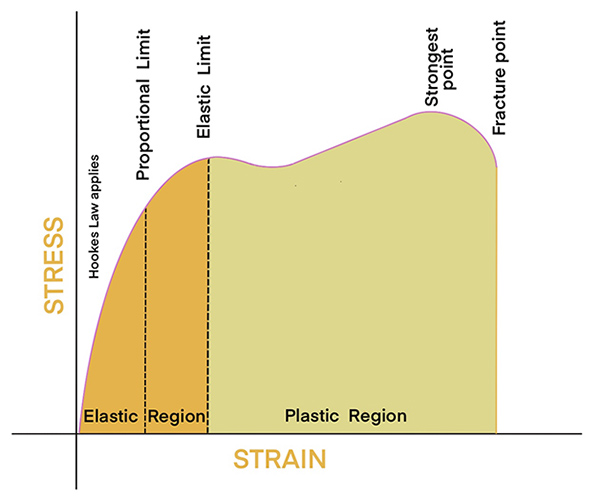Plasticity in construction
The term 'plasticity' refers to the degree to which as material has the characteristic of being easily shaped, moulded or formed. More specifically in terms of material science and building physics it relates to the terms plastic region and plastic deformation - where a material is unable to retain elasticity (return to its original shape), or as such has the ability to undergo permanent deformation in response to forces being applied. It is the middle stage of the characteristic behaviour of materials under stress and strain from forces being applied, the first stage being elasticity and the last stage being fracture or failure.
It is important to note that plasticity refers to a materials characteristics rather than being a reference to a particular type of material, such as plastic.
For example, natural clay has the characteristic of plasticity because it can be moulded into any shape, but also wood can have the characteristic of plasticity, where timber beams for example over years become permanently bowed but retain their strength and do not reach fracture point.
Plastics may also posses plasticity as a characteristic when they are heated and moulded into for example building components.
The level that a material can sustain plastic deformation under tensile force is referred to as ductility, whilst a material's ability to deform plastically without failing under compressive stresses is referred to as malleability.
A material that has a very small plastic region and potentially elastic region also is referred to as brittle.
[edit] Related articles on Designing Buildings
Featured articles and news
The UK's Modern Industrial Strategy: A 10 year plan
Previous consultation criticism, current key elements and general support with some persisting reservations.
Building Safety Regulator reforms
New roles, new staff and a new fast track service pave the way for a single construction regulator.
Architectural Technologist CPDs and Communications
CIAT CPD… and how you can do it!
Cooling centres and cool spaces
Managing extreme heat in cities by directing the public to places for heat stress relief and water sources.
Winter gardens: A brief history and warm variations
Extending the season with glass in different forms and terms.
Restoring Great Yarmouth's Winter Gardens
Transforming one of the least sustainable constructions imaginable.
Construction Skills Mission Board launch sector drive
Newly formed government and industry collaboration set strategy for recruiting an additional 100,000 construction workers a year.
New Architects Code comes into effect in September 2025
ARB Architects Code of Conduct and Practice available with ongoing consultation regarding guidance.
Welsh Skills Body (Medr) launches ambitious plan
The new skills body brings together funding and regulation of tertiary education and research for the devolved nation.
Paul Gandy FCIOB announced as next CIOB President
Former Tilbury Douglas CEO takes helm.
UK Infrastructure: A 10 Year Strategy. In brief with reactions
With the National Infrastructure and Service Transformation Authority (NISTA).
Ebenezer Howard: inventor of the garden city. Book review.
The Grenfell Tower fire, eight years on
A time to pause and reflect as Dubai tower block fire reported just before anniversary.
Airtightness Topic Guide BSRIA TG 27/2025
Explaining the basics of airtightness, what it is, why it's important, when it's required and how it's carried out.
Construction contract awards hit lowest point of 2025
Plummeting for second consecutive month, intensifying concerns for housing and infrastructure goals.
Understanding Mental Health in the Built Environment 2025
Examining the state of mental health in construction, shedding light on levels of stress, anxiety and depression.























Comments
[edit] To make a comment about this article, or to suggest changes, click 'Add a comment' above. Separate your comments from any existing comments by inserting a horizontal line.